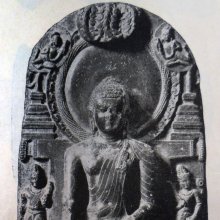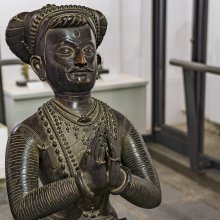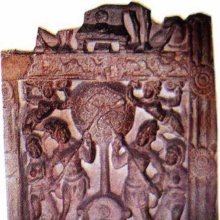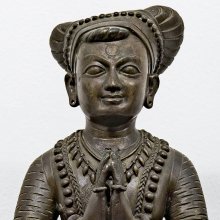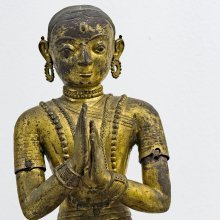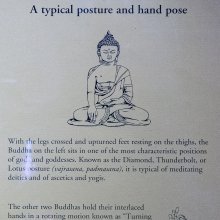Vajrasana, Vajra-asana, Vajrāsana: 22 definitions
Introduction:
Vajrasana means something in Buddhism, Pali, Hinduism, Sanskrit, Jainism, Prakrit, the history of ancient India, Marathi. If you want to know the exact meaning, history, etymology or English translation of this term then check out the descriptions on this page. Add your comment or reference to a book if you want to contribute to this summary article.
Images (photo gallery)
(+1 more images available)
In Hinduism
Yoga (school of philosophy)
Source: Wisdom Library: YogaVajrāsana (वज्रासन) is one of the eighty-four āsanas (postures) taught by Śiva, according to the Haṭharatnāvalī 3.7-20. It is said that Ādinātha (Śiva) hand-picked 84 yoga postures from 84,00,000 living beings and taught them for the purpose of introducing physical health and well-being to the human body. The compound bhadrāsana consists of the words vajra (thunderbolt) and āsana (posture).
Source: Google Books: The Hatha Yoga PradipikaVajrāsana (वज्रासन) is another name for siddhāsana: an āsana (posture) taught by Śiva and one of the first four out of 84 total, thus one of the most essential, according to Haṭhayogapradīpikā I.37-45.—Accordingly, “Press firmly the heel of the left foot against the perineum, and the right heel above the male organ. With the chin pressing on the chest, one should sit calmly, having restrained the senses, and gaze steadily the space between the eyebrows. This is called the siddhāsana, the opener of the door of salvation”.
Also, “This siddhāsana is performed also by placing the left heel on Meḍhra (above the male organ), and then placing the right one on it. Some call this siddhāsana, some vajrāsana. Others call it muktāsana or guptāsana. Out of the 84 āsanas, siddhāsana should always be practised, because it cleanses the impurities of 72,000 nāḍīs”.
The 15th-century Haṭhayogapradīpikā by Svātmārāma is one of the oldest extant texts dealing with haṭhayoga: an ancient form of meditation founded by Matsyendranātha. The first chapter of this book describes various āsanas (e.g., vajra-āsana).
Source: archive.org: Yoga Tradition of the Mysore PalaceVajrāsana (वज्रासन) is a type of standing posture (āsana), according to verse 68 of the Śrītattvanidhi.—Accordingly, “Press the perineum with one heel and the penis with the other. This is vajrāsana, the diamond”.
The 19th-century Śrītattvanidhi is a sanskrit treatise describing 80 primary āsanas, or ‘posture’ (e.g., vajra-āsana) and several additional ones.
Suptavajrāsana is found in Iyengar but the base vajrāsana is not. These meditation āsanas are referred to in many texts and the descriptions vary somewhat. It appears that vajrāsana refers to the position where the legs are folded back and sat on or between. Iyengar seems to call this position vīrāsana and his book is not entirely clear as there are contrary indications when the variation nare considered. For example, his suptavajrāsana really appears to be a variation of matsyāsana. Even though he has the vīrāsana series as above, he has a laghuvajrāsana which does adopt the leg position and would awaken the expectation of a basic vajrāsana.
Yoga-mīmāṃsā III.2, p. 135 states:
“The name vajrāsana is often used for siddhāsana... When we remember the meaning of the word vajra in Yogic literature and also take into consideration that in siddhāsana one of the heels is set at the root of the penis, we can understand why... (siddhāsana)... is also called vajrāsana.”
Vajrāsana is described in Gheraṇḍasaṃhitā II.12 as having feet on either side of the buttocks. In Yogakuṇḍalinyupaniṣat the variation with a heel under the penis is described. According to Haṭhapradīpikā it is another name for siddhāsana.
Source: archive.org: Gheranda SamhitaVajrāsana (वज्रासन) is one of the thirty-two āsanas (postures) taught in the second chapter of the Gheraṇḍasaṃhitā: “Making the lower legs tight one should place the two feet on either side of the anus. This is called Vajrāsana. It brings success to the yogis”.
Vajrāsana is one of the selected 32 postures amongs 8,400,000 total mentioned by Śiva, according to Gheraṇḍasaṃhitā 2.1-2, “In all, there are as many Āsanas as species of animals. Eighty-four lacs of them are mentioned by Śiva. Out of them, 84 are regarded as important and among these 84, again 32 are good (enough) in this world of mortal beings”.
The 17th-century Gheraṇḍasaṃhitā (mentioning vajra-āsana) is one of the three classic texts of Haṭha-yoga: a major branch of Yoga, sharing similarities with the Yoga system taught by Patañjali, though claiming its own mythical founder known as Matsyendranātha. This gheraṇḍa-saṃhitā is an encyclopedic Sanskrit treatise describing thirty two such āsanas.
Source: ORA: Amanaska (king of all yogas): A Critical Edition and Annotated Translation by Jason BirchVajrāsana (वज्रासन) refers to a particular posture, according to the Yogabīja 125-26 and Gorakṣaśataka 79-84.—Accordingly, “Seated in Vajrāsana and having caused Kuṇḍalinī to stir, [the Yogin] should perform [the Prāṇāyāma known as] Bhastrā [so that] he quickly awakens Kuṇḍalinī. The knots in the spine are pierced with [this] rod of molten iron”.

Yoga is originally considered a branch of Hindu philosophy (astika), but both ancient and modern Yoga combine the physical, mental and spiritual. Yoga teaches various physical techniques also known as āsanas (postures), used for various purposes (eg., meditation, contemplation, relaxation).
Shaktism (Shakta philosophy)
Source: Google Books: ManthanabhairavatantramVajrāsana (वज्रासन) refers to the “adamantine posture”, according to the Śrīmatottara-tantra, an expansion of the Kubjikāmatatantra: the earliest popular and most authoritative Tantra of the Kubjikā cult.—Accordingly, while describing the Mūrti (visualized iconic form) of the goddess Mālinī: “She is like the rising sun and is blissful with wine. Very beautiful, she has five faces and is radiant with five time three eyes. [...] Three wrinkles (adorn her) middle part and she has large, upraised breasts. She has a necklace and bracelets adorned with jewels and gems. The goddess sits in the adamantine posture [i.e., vajrāsana-gatā] on a cot. She wears a garland of vowels on her head and a divine necklace of letters around her neck”.
Source: academia.edu: The Śāradātilakatantra on YogaVajrāsana (वज्रासन) refers to one of the five āsanas (postures) explained by Lakṣmaṇadeśika in his 11th-century Śaradātilaka verse 25.14cd-15ab.—“He should place both feet, one after the other, on both thighs; he should place both hands, his fingers turned towards [himself], on both knees. [This is] called the most excellent diamond posture (vajrāsana)”.

Shakta (शाक्त, śākta) or Shaktism (śāktism) represents a tradition of Hinduism where the Goddess (Devi) is revered and worshipped. Shakta literature includes a range of scriptures, including various Agamas and Tantras, although its roots may be traced back to the Vedas.
Shilpashastra (iconography)
Source: Shodhganga: The significance of the mūla-beras (śilpa)Vajrāsana (वज्रासन) or Paryaṅkāsana in the Buddhist tradition corresponds with Padmāsana or Kamalāsana: a type of Āsana (sitting poses), according to Ganapati Sthapati in his text Ciṟpa Cennūl, as defined according to texts dealing with śilpa (arts and crafs), known as śilpaśāstras.—An image sitting cross-legged, with the feet facing upwards and resting on the thighs, and the body held erect, is said to be in padmāsana or kamalāsana. This posture is also known as paryaṅkāsana or vajrāsana in the Buddhist tradition. When one leg is folded, with the other foot resting on its thigh, it is called ardhapadmāsana.

Shilpashastra (शिल्पशास्त्र, śilpaśāstra) represents the ancient Indian science (shastra) of creative arts (shilpa) such as sculpture, iconography and painting. Closely related to Vastushastra (architecture), they often share the same literature.
Pancaratra (worship of Nārāyaṇa)
Source: archive.org: Catalogue of Pancaratra Agama TextsVajrāsana (वज्रासन) refers to one of the Mudrās mentioned in the eighteenth chapter of the Agastyasaṃhitā (agastya-suīkṣṇa-saṃvāda edition), an ancient Pāñcarātra Āgama text dealing with the worship of Rāma, Sītā, Lakṣmaṇa and Hanumān.—[Cf. the chapter pūjāsādhanalakṣaṇa].—[...] One should offer pūjā with devotion [bhakti] and orderliness [saṃkalpa]. [...] Postures [āsana] to be assumed during worship are then discussed—with descriptions of the following: [e.g., vajrāsana]. There are many others, the text adds, any one of which can be selected for the repetition of God’s names and for other pious activities [japādi].

Pancaratra (पाञ्चरात्र, pāñcarātra) represents a tradition of Hinduism where Narayana is revered and worshipped. Closeley related to Vaishnavism, the Pancaratra literature includes various Agamas and tantras incorporating many Vaishnava philosophies.
In Buddhism
Tibetan Buddhism (Vajrayana or tantric Buddhism)
Source: archive.org: The Indian Buddhist IconographyVajrāsana (वज्रासन) (or Gautama) is another name for Śākyasiṃha: one of the seven mortal Buddhas (mānuṣī) whose names appear last in the list of thirty-two Buddhas in Mahāyāna Buddhism.—The last seven Tathāgatas are well-known, and are designated by the Mahāyānist as Mānuṣī or “Mortal Buddhas”. When represented, the last seven Mortal Buddhas appear all alike; they are of one colour and one form, usually sitting cross-legged,with the right hand disposed in the Bhūmisparśa-mudrā (earth-touching attitute), which is the mudrā peculiar to Akṣobhya. [...] In paintings, the Mortal Buddhas [viz., Vajrāsana] have usually a yellow or golden complexion. [...] Sometimes they are represented as standing, in which case the appear under a distinguishing Bodhi Tree and with a distinguishing mudrā.
Buddha Vajrāsana is descirbed in the Sādhanamālā as follows: “The worshipper should meditate himself as (Vajrāsana) who displays the Bhūṣparśa (Bhūsparśa) Mudrā in his right hand while the left rests on the lap. He is dressed in red garments and sits on the Vajra-marked double lotus placed on the four Māras of blue, white, red and green colour. He is peaceful in appearance and his body is endowed with all the major and minor auspicious marks. To the right of the God is Maitreya Bodhisattva who is white, two-armed, and wears the Jaṭāmukuṭa (crown of matted hair), and carries the chowrie-Jewel in the right hand, and the Nāgakeśara flower in the left. Similarly, to the left of the principal God is Lokeśvara of white complexion, carrying in his right hand the chowrie and the lotus in the left. These two gods should be meditated upon as looking towards the face of the (principal) god...... Here ends the Sādhana for Vajrāsana”.
Source: OSU Press: Cakrasamvara SamadhiVajrāsana (वज्रासन) refers to the “vajra-seat” [i.e., oṃ ... tiṣṭha vajrāsane svāhā], according to the Guru Mandala Worship (maṇḍalārcana) ritual often performed in combination with the Cakrasaṃvara Samādhi, which refers to the primary pūjā and sādhanā practice of Newah Mahāyāna-Vajrayāna Buddhists in Nepal.

Tibetan Buddhism includes schools such as Nyingma, Kadampa, Kagyu and Gelug. Their primary canon of literature is divided in two broad categories: The Kangyur, which consists of Buddha’s words, and the Tengyur, which includes commentaries from various sources. Esotericism and tantra techniques (vajrayāna) are collected indepently.
In Jainism
General definition (in Jainism)
Source: archive.org: The Jaina IconographyVajrāsana (वज्रासन) refers to one of the various āsanas (postures) commonly depcited in Jain iconography.—It is well-known that the Indian Yogīs practise the various Āsanas to gain some control of the body, proceeding as they do, towards the Rāja-yoga or higher mental culture.
Source: archive.org: TrisastisalakapurusacaritraVajrāsana (वज्रासन) or simply Vajra is the name of a posture (āsana), according to chapter 2.1 [ajitanātha-caritra] of Hemacandra’s 11th century Triṣaṣṭiśalākāpuruṣacaritra: an ancient Sanskrit epic poem narrating the history and legends of sixty-three illustrious persons in Jainism.
Accordingly, “the elephant of kings (i.e., Vimalavāhana) dismounted from the elephant’s shoulder and entered the garden, like a lion a mountain-cave. [...] He saw monks there, too, some in the [viz., vajrāsana-posture, ...] some engaged in kāyotsarga, and some in ukṣa-posture, indifferent to the body, who had carried out their vows in the midst of numerous attacks, like soldiers in battles, victorious over internal enemies, enduring trials, powerful from penance and meditation [...] The King, with devotion sprouted in the guise of horripilation, as it were, approached Ācārya Arindama and paid homage to him”.
Source: The University of Sydney: A study of the Twelve ReflectionsVajrāsana (वज्रासन) (Cf. Vajra) refers to the “thunderbolt posture”, according to the 11th century Jñānārṇava, a treatise on Jain Yoga in roughly 2200 Sanskrit verses composed by Śubhacandra.—Accordingly, “On a flat piece of wood or stone, on the ground or on sandy soil, the wise [person] should adopt a stable posture for the accomplishment of absorption. Thus, sitting cross-legged, sitting half cross-legged, thunderbolt, hero posture (vajrāsana—vajraṃ vīrāsanaṃ) and the previously mentioned pleasant and lotus [postures] as well as abandonment of the body is highly thought of. [...]”.

Jainism is an Indian religion of Dharma whose doctrine revolves around harmlessness (ahimsa) towards every living being. The two major branches (Digambara and Svetambara) of Jainism stimulate self-control (or, shramana, ‘self-reliance’) and spiritual development through a path of peace for the soul to progess to the ultimate goal.
India history and geography
Source: Cologne Digital Sanskrit Dictionaries: Indian Epigraphical GlossaryVajrāsana.—(LL), name of the seat on which the Buddha sat for meditation for the attainment of supreme knowledge (bodhi). Note: vajrāsana is defined in the “Indian epigraphical glossary” as it can be found on ancient inscriptions commonly written in Sanskrit, Prakrit or Dravidian languages.

The history of India traces the identification of countries, villages, towns and other regions of India, as well as mythology, zoology, royal dynasties, rulers, tribes, local festivities and traditions and regional languages. Ancient India enjoyed religious freedom and encourages the path of Dharma, a concept common to Buddhism, Hinduism, and Jainism.
Languages of India and abroad
Marathi-English dictionary
Source: DDSA: The Molesworth Marathi and English Dictionaryvajrāsana (वज्रासन).—n (S) A particular attitude or posture. 2 A firm seat (as on horseback). 3 fig. A firm tenure (of an office or an authority).
Source: DDSA: The Aryabhusan school dictionary, Marathi-Englishvajrāsana (वज्रासन).—n A firm seat (as on horse-back).
Marathi is an Indo-European language having over 70 million native speakers people in (predominantly) Maharashtra India. Marathi, like many other Indo-Aryan languages, evolved from early forms of Prakrit, which itself is a subset of Sanskrit, one of the most ancient languages of the world.
Sanskrit dictionary
Source: DDSA: The practical Sanskrit-English dictionaryVajrāsana (वज्रासन).—
1) a diamond-seat.
2) a particular posture in sitting (the hands being placed in the hollow between the body and the crossed feet).
Derivable forms: vajrāsanam (वज्रासनम्).
Vajrāsana is a Sanskrit compound consisting of the terms vajra and āsana (आसन).
Source: Cologne Digital Sanskrit Dictionaries: Monier-Williams Sanskrit-English Dictionary1) Vajrāsana (वज्रासन):—[from vajra > vaj] n. a diamond seat, [Buddhist literature]
2) [v.s. ...] a [particular] posture in sitting (the hands being placed in the hollow between the body and the crossed feet), [Hemacandra’s Yoga-śāstra]
3) [v.s. ...] m. Name of Buddha, [Inscriptions]
[Sanskrit to German]
Sanskrit, also spelled संस्कृतम् (saṃskṛtam), is an ancient language of India commonly seen as the grandmother of the Indo-European language family (even English!). Closely allied with Prakrit and Pali, Sanskrit is more exhaustive in both grammar and terms and has the most extensive collection of literature in the world, greatly surpassing its sister-languages Greek and Latin.
Kannada-English dictionary
Source: Alar: Kannada-English corpusVajrāsana (ವಜ್ರಾಸನ):—
1) [noun] a diamond throne.
2) [noun] (archit.) the miraculous throne under the Bōdhi tree on which the Buddha sat at the time of attaining the perfect wisdom.
3) [noun] (yoga.) a yogic sitting posture in which the anus is pressed with the back part of the foot.
Kannada is a Dravidian language (as opposed to the Indo-European language family) mainly spoken in the southwestern region of India.
See also (Relevant definitions)
Partial matches: Vajra, Asana.
Starts with: Vajrasanastha.
Ends with: Laghuvajrasana, Suptavajrasana, Suptordhvapadavajrasana.
Full-text (+12): Asana, Paryankasana, Vamsha, Gautama, Loha, Tapta, Salaka, Calayitva, Taptaloha, Asanasthita, Bhastra, Iron, Spine, Molten iron, Virasana, Pithipati, Bodh Gaya, Kamalasana, Vajra, Bodhimanda.
Relevant text
Search found 19 books and stories containing Vajrasana, Vajra-asana, Vajrāsana, Vajra-āsana; (plurals include: Vajrasanas, asanas, Vajrāsanas, āsanas). You can also click to the full overview containing English textual excerpts. Below are direct links for the most relevant articles:
Amaravati Art in the Context of Andhra Archaeology (by Sreyashi Ray chowdhuri)
Vajrāsana and Siṃhāsana < [Chapter 3 - Amarāvatī and the Formative Stage of the Buddhist Art]
Triratna (triple refuge) < [Chapter 3 - Amarāvatī and the Formative Stage of the Buddhist Art]
Maha Prajnaparamita Sastra (by Gelongma Karma Migme Chödrön)
Part 12 - Changing the surrounding ground into diamond < [Chapter LI - Seeing all the Buddha Fields]
Appendix 2 - The deity of the Bodhi tree (bodhivṛkṣadevatā) < [Chapter VI - The Great Bhikṣu Saṃgha]
IV. Supplementary explanations < [Part 2 - Understanding dharmatā and its synonyms]
Jnaneshwari (Bhavartha Dipika) (by Ramchandra Keshav Bhagwat)
Verse 12.3-4 < [Chapter 12 - Bhakti-yoga]
Verse 6.12 < [Chapter 6 - Dhyana-yoga]
Verse 8.4 < [Chapter 8 - Akshara-brahman-yoga]
The Indian Buddhist Iconography (by Benoytosh Bhattachacharyya)
Blue Annals (deb-ther sngon-po) (by George N. Roerich)
Chapter 5b - The Separate Lineage (brgyud pa thor bu ba) < [Book 12 - Peace-Making Lineages]
Chapter 7 - Kālacakra lineage: Somanātha < [Book 10 - The Kālacakra]
Chapter 12 - Teurapa (rte'u ra pa'i skabs) < [Book 14 - Great Compassion Cycle]
Sripura (Archaeological Survey) (by Bikash Chandra Pradhan)
Scultures of Buddhist Goddesses (3): Vajratara < [Chapter 3 - Sculptural Programme]
Scultures of Buddha in Bhusparsa-mudra < [Chapter 3 - Sculptural Programme]
Related products
